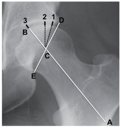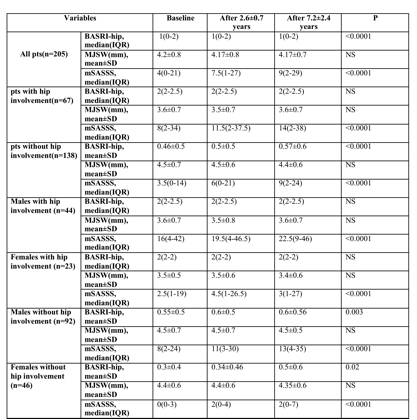Session Information
Session Type: ACR Poster Session A
Session Time: 9:00AM-11:00AM
Background/Purpose: Although current evidence suggests that anti-TNF treatment may not inhibit spinal radiographic progression, its effect on hip involvement in AS is not known. The aim of this study is to assess the impact of long-term anti-TNF treatment on radiographic progression of hip arthritis in AS, by adding a quantitative scoring method, previously applied in hip osteoarthritis, to BASRI-hip score.
Methods: 205 consecutive AS patients (136 men, age: 49±11years, disease duration: 23±11 years) under anti-TNF treatment were included in this retrospective study. Anteroposterior X-rays of pelvis and lateral spine X-rays were scored blindly, by 2 independent readers at 3 time points: at baseline (i.e. prior anti-TNF treatment initiation), 2.6±0.7 and 7.2±2.4 years after anti-TNF initiation. Both hips were scored using: a) BASRI-hip score, b) mean joint space width (MJSW), estimated by measurement of 3 distinct points of interbone distance: 2 mm inner of the external end of the acetabulum, vertical line through femoral head center, head-neck center line(Figure). Spinal X-rays were scored by the mSASSS. Hip involvement was assessed clinically (pain, reduced range of motion and intermalleolar distance) and radiographically, as BASRI-h score ³ 2 at baseline anteroposterior pelvis X-rays. The significance of changes was tested by mixed models for longitudinal data.
Results: Definite hip involvement at baseline, was detected in 67/205(33%) patients, who had significantly higher BASRI-hip score[2(2-2.5)median(IQR) vs. 0.5(0-1) p<0.0001] and lower MJSW (3.6±0.7 vs. 4.5±0.7, p<0.0001), compared to those without. In AS patients with hip arthritis at baseline, both BASRI-h score and MJSW remained unchanged during follow up, regardless of gender. In patients without hip arthritis, the BASRI-hip score remained unchanged after 2.6±0.7 years, but increased significantly after 7.2±2.4 years compared to baseline. In particular, the BASRI-hip score showed significant increase in AS males without hip arthritis at the two intervals, compared to correspondence females, who had significant increase only at follow-up end. In contrast, the MJSW in patients without hip arthritis remained unchanged at the three time points, both in males and females. The mSASSS raised significantly during the follow-up period, regardless of gender and hip involvement (table).
Conclusion: One third of the AS patients suffer from radiographic hip involvement, that appears to stabilize during long-term anti-TNF treatment. The new scoring system may contribute to detect minor changes in contrast to BASRI-hip scoreÕ rough estimation. 
To cite this abstract in AMA style:
Konsta M, Nurmohamed M, van Denderen JC, Visman I, Van der Horst - Bruinsma IE. Radiographic Progression of Hip Arthritis in Patients with Ankylosing Spondylitis Treated with TNF Inhibitors [abstract]. Arthritis Rheumatol. 2016; 68 (suppl 10). https://acrabstracts.org/abstract/radiographic-progression-of-hip-arthritis-in-patients-with-ankylosing-spondylitis-treated-with-tnf-inhibitors/. Accessed .« Back to 2016 ACR/ARHP Annual Meeting
ACR Meeting Abstracts - https://acrabstracts.org/abstract/radiographic-progression-of-hip-arthritis-in-patients-with-ankylosing-spondylitis-treated-with-tnf-inhibitors/

